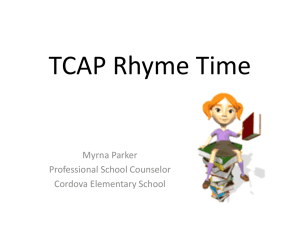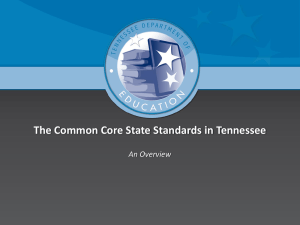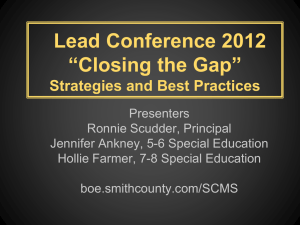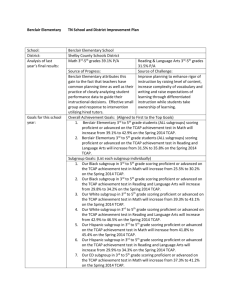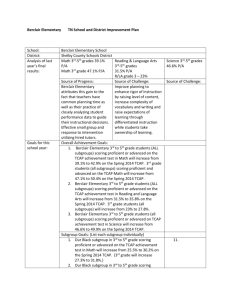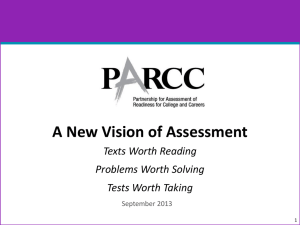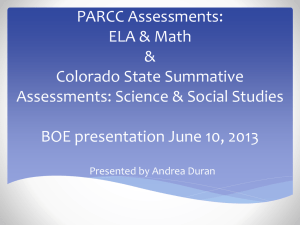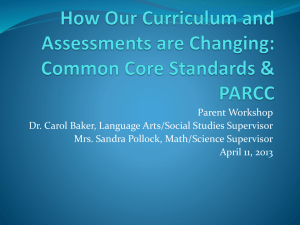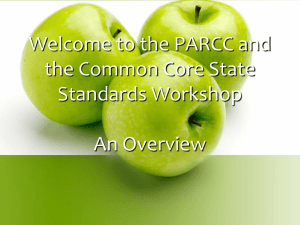TCAP Writing Assessment Presentation
advertisement
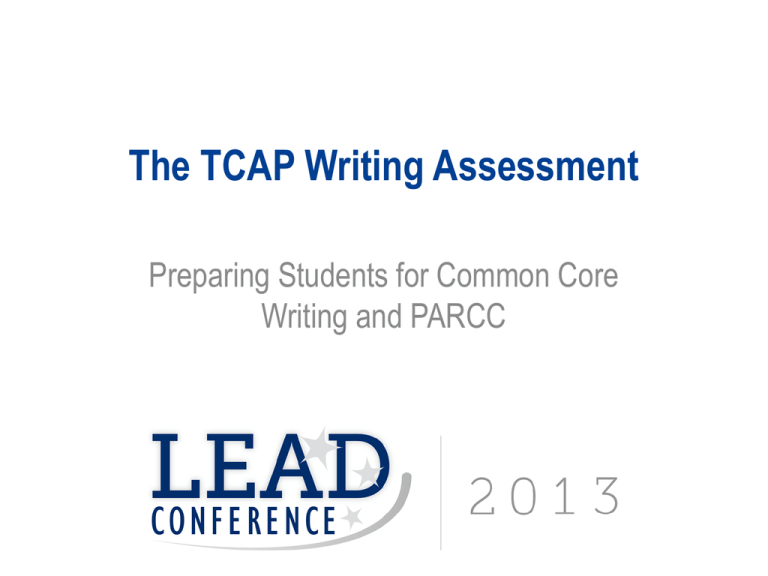
The TCAP Writing Assessment Preparing Students for Common Core Writing and PARCC Session objectives The past: 1. Analyze results from the 2013 TCAP Writing Assessment The present: 2. Know the format of the 2014 TCAP Writing Assessment The future: 3. Learn from one district’s approach to the transition to Common Core writing 4. Understand the landscape of resources available to help educators and students prepare for the TCAP WA and PARCC THE PAST Data from previous TCAP WA Statewide: total percentage of students proficient or advanced (all grade levels) 100.0% 90.0% 84.9% 86.0% 88.7% 80.0% 70.0% 60.0% 2009-10 50.0% 40.0% 2010-11 30.0% 2011-12 20.0% 10.0% 0.0% 2009-10 2010-11 2011-12 Nationwide results from NAEP writing 2011 Source: The Nation’s Report Card: http://nationsreportcard.gov/writing_2011/summary.asp Assessment evolution: 2012 TCAP WA 8th grade prompt There are many reasons for people to celebrate. People celebrate some events every year, while other celebrations take place for special occasions. Before you begin writing, think about your favorite celebration and why you enjoy it most. Now write an essay that tells about your favorite celebration. Explain why this is your favorite celebration. Support your reasons with specific examples and details. Assessment evolution: 2013 TCAP WA 8th grade prompt Settling New Lands Write an expository essay comparing and contrasting how reasons for colonization have changed from settling America to attempting to settle space. Analyze how the texts provide conflicting information about why settling new lands is important. Draw evidence from the passages to support your analysis. Develop your topic with relevant, well-chosen facts, concrete details, or other information and examples. Demonstrate command of the conventions of standard English, capitalization, punctuation, and spelling in your response. Introduction to Tennessee’s trait-based rubric 2012-13 2013-14 Support/Elaboration Development Focus/Organization Focus/Organization Language/Style Language Conventions Conventions 2013 TCAP WA statewide results With a partner, scan the “Statewide Results and Instructional Implications for Common Core Writing” memo (data appendix on last page). Note there are teacher-facing grade-level versions behind the overall memo. Then discuss the following questions with your table: 1) How would you explain the reasons for students struggling in certain traits? 2) In what ways do the results reinforce what you’ve seen with your students? In what ways do your students differ? THE PRESENT Assessment transition to PARCC 2011-2012 2012-2013 2013-2014 2014-2015 TCAP Achievement and EOC Assessments Low Stakes Common Core-aligned Assessments PARCC Continue to remove SPIs that are not reflected in Common Core State Standards from the TCAP mathematics and ELA assessments in 2013-14. Expand the Constructed Response Assessment (CRA) in math for all grades 1-8 and HS. Expand the Writing Assessment to all grades 3-11 to test online. NAEP NAEP 2013-14 assessment transition: ELA Streamline •TCAP Achievement tests will be narrowed 20-35 percent in RLA (3-8) official •TCAP EOCs will be narrowed 20-30 percent in English I, II, and III assessments Expand low- •The Writing Assessment will still be required in grades 5, 8, and 11 in stakes February. The offerings will be expanded to all grades 3-11. assessments •The February Writing Assessment will be scored by Measurement Incorporated for all grades that districts choose to assess. Provide additional resources •September: optional practice writing tasks released for each grade band for ELA, science, and social studies. These tasks are recommended for teacher, school, and district use. •November: Scoring rubrics and anchor papers for scoring writing tasks will be posted (scoring of student work will be done locally by teachers) •November: Updated MIST portal launches; students can take practice tasks online •Early spring: second round of practice writing tasks released (followed by scoring resources) 2013-14 TCAP WA: Administration • Districts will still be required to administer the writing assessment in grades 5, 8, and 11. • There will be a four-week testing window from February 3 – February 28, 2014. • The administration time for the Writing Assessment will be expanded to more closely mimic PARCC’s testing guidelines and allow students to read two texts and write two essays 2013-14 TCAP WA: Format • Will be modified to more closely mimic the PARCC Research Simulation Task (RST) – mimics a research project that assesses a student’s ability to read multiple texts about the same topic and synthesize the information into a coherent idea/argument. • Students will read two complex informational stimulus texts • Texts will cover social studies or science topics in order to demonstrate the range of informational reading possible in a Common Core curriculum (background knowledge not required) • Students will write two essays: – One prose constructed response (PCR) about the first text. The essay will be an analytical summary (informational/explanatory) – One PCR analysis of both texts. The essay will be informational/explanatory or opinion/argument. Assessment evolution: 2013-14 TCAP WA 8th grade practice prompt 1. Analytic Summary Please read “The Woman Called Moses” by Walter Oleksy and Meg Mims. In this text, the authors develop several central ideas. After you have read, determine one central idea from the text and write an essay that both summarizes and analyzes how that central idea is conveyed through particular details. Cite evidence from the text to support your analysis. Follow the conventions of standard written English. Write your essay in the space provided on the next pages. Assessment evolution: 2013-14 TCAP WA 8th grade practice prompt 2. Analysis Please read “Leaders of the Civil War Era: Harriet Tubman” by Ann Malaspina. You have now read two texts about Harriet Tubman. Write an essay that compares and contrasts the authors’ purposes and how their purposes are conveyed in the two texts. Be sure to cite evidence from both texts to support your analysis. Follow the conventions of standard written English. Write your essay in the space provided on the next pages. TCAP WA: Scoring and Reporting Information • Reports for Writing are being redesigned and will be available during the summer of 2014 • Individual Student Reports and labels will be shipped to districts. • Summary reports will be available online through the MI portal. TCAP WA: Accountability • 2013-14: District and school accountability and TVAAS calculations will continue to be based on the TCAP Achievement and End of Course Tests (and additional growth measures such as K-2 [SAT10] for those opting in). • 2013-14: The Writing Assessment will play no role in TVAAS or district/school AMOs. • 2014-15: Accountability will move to performance on PARCC. The approach to setting goals for accountability for the 201415 school year will be subject to our NCLB waiver. More information will be shared as soon as it is available from the U.S. Department of Education. MIST Literacy Portal: Background Why it’s worth accessing: • Additional student and teacher practice with online assessment before PARCC • Students get practice with tasks modeled on the Writing Assessment before February 2014 • Teachers can enter and save scores for student work MIST Literacy Portal: Background What it contains: • Will house optional practice writing tasks by grade band in ELA, science, social studies, and CTE – tasks have been developed to prepare students for the Writing Assessment and increase literacy skills across other subjects • Students will be able to read texts and text-based tasks and type their responses online. • Students will have access to some PARCC-like tools such as the ability to highlight and enlarge text. MIST Literacy Portal: User interface MIST Literacy Portal: Availability Month Tasks available in Literacy Portal Content Grades/Grade Bands Mid-November 2013 – Mid-January 2014 Phase I tasks available on Literacy Portal on MIST ELA 3, 4-5, 6-8, 9-10, 11 Science, Social Studies 6-8, 9-12 CTE 9-12 February 2014 March – May 2014 Phase II - Official Writing Assessment Only Phase III Tasks available on Literacy Portal on MIST, as well as all Phase I tasks 3, 4-5, 6-8, 9-10, 11 ELA ELA 3, 4-5, 6-8, 9-10, 11 Science, Social Studies 6-8, 9-12 CTE 9-12 2013-14: Assessment release timeline • Get to know PARCC, including NEW sample items and rubrics: www.parcconline.org (Also: PARCC test design, blueprints, and Model Content Frameworks) • Stay informed about information the TDOE is sharing: – www.tncore.org (including dropped SPI list, text complexity tools, summer training materials, and much more!) – Coming: TCAP WA information page, assessment transition plan – Sign up for TNCore Updates • Continue your own professional learning: – Student Achievement Partners: http://www.achievethecore.org/. Includes PD modules, including iTunesU courses. Additional Resources • Resources to help educators access, analyze, and act on data from last year’s TCAP WA, including webinars and statewide results memo/grade-level summaries: http://tncore.org/english_language_arts/assessment/testing_information.aspx • Resources available to help educators and students prepare for this year’s TCAP WA: – Phase I practice prompts: http://tncore.org/english_language_arts/assessment/sample_assessments/201 3-14sampleassessments.aspx – MIST literacy portal – Rubrics and, coming in November, scoring resources: http://tncore.org/english_language_arts/assessment/scoring_resources/201314scoringresources.aspx • Assessment transition/timeline release memos: http://www.tncore.org/english_language_arts/assessment/testing_information.aspx Navigating practice prompts Navigating practice prompts Navigating practice prompts User name: tneducation Password: fastestimproving Navigating practice prompts THE FUTURE Backwards Planning: What do the new writing tasks ask our students to know and do? Text-based Writing Assessment • Shift away from free-response prompt • Read to write • Use text evidence Modes of Writing • Focused/Organized • Formal Development • Academic Specific Language Reading Complex Text • Read to gain information • Understand author’s purpose Text-based writing assessment If students must: – Shift away from free response prompt – Read to write vs. reading for enjoyment – Use text evidence from reading (annotation) Then, we must shift our teaching to: – Develop prompt analysis as a pre-reading skill – Practice close reading to gain deeper text understanding (Metacognitive processes) – Model annotation strategies for students to find quality evidence Modes of writing If students must: – Be focused/organized – Use formal development (support and elaboration) – Apply academic specific language to writing Then, we must shift our teaching to: – Incorporate all writing structures for all students every year (not focus on a type of writing per year) – Help students use evidence and elaboration to support arguments and analysis – Develop strategies for understanding content vocabulary in reading to use accurately in writing Sample Writing Map Reading complex text If students must: – Read to gain information – Understand author’s purpose Then, we must shift our teaching to: – Focus on close reading skills and annotation strategies rather than skimming a text to answer questions at the end of a section – Read authentic text samples to write about them and write for an audience Also transitioning to Common Core requires specific instructional shifts: Shift One: Develop Content Knowledge • Support deep content understanding from reading vs. note-taking • Develop strategies for reading content Shift Two: Reading & Writing with Evidence • Use annotations while reading • Distinguish important vs. interesting WHILE reading Shift Three: Regular practice with complex text • Develop strategies for reading fluently and using metacognitive skills • Engage in practice reading rigorous texts Focal Strategies Close Reading • Annotation • System of strategies • Quality Evidence Gathering Authentic Text •Scaffolding text rigor •Library of content texts Writing Structures •Teaching purpose of writing types •Teaching structured development •Teacher PD on rubrics, anchor papers, and scoring Close Reading At Sumner County Schools • Trained experts in each building • Modeled by expert in all content areas • Developed simple system of strategies school-wide in each building (tailored to student needs) • Held three professional learning sessions • Collect accountability logs monthly Using Teacher Experts • Created a core group of teachers across the county that had summer professional learning (in collaboration with Lipscomb University) on close reading • Provided time for teacher experts to give building-wide professional learning on close reading before school started • Created video models to provide additional on-demand professional development on close reading • Additional modeling for struggling teachers Authentic Text At Sumner County Schools • Taught three prong text analysis (quantitative, qualitative, text to reader match) • Creating shared database of authentic article sources • Scaffolding text complexity to meet students at need levels Authentic Text Collaborative Free Database Writing Structures At Sumner County Schools • Trained all staff in rubric using anchor papers • Incorporate writing maps, scoring, and anchor papers during second semester • Incorporate system of applying annotations and evidence collection to writing task • Use Literacy Design Collaborative to create quality prompt-based tasks Three Starting Points for Implementing Common Core Writing 1. Teacher Professional Learning on two writing rubrics, tasks, and anchor papers – Focused time around “What will a student need to do” and “what will I need to teach them to do” 2. One to Two Student Practice Text-Based Prompts – One argumentative and possibly one informative (samples available at TNCore website) 3. Teacher Professional Learning around Common Scoring and Data Analysis – Use anchors for teachers to apply first PL and discuss student strengths/challenges Resources • www.tncore.org: assessment information, sample assessment tasks, close reading tasks, units, summer training materials, and more • http://www.parcconline.org/: Info on PARCC PBA and sample items • http://www.achievethecore.org/: ELA section features sample close reading lessons, archive of student writing samples, PD modules, and more • http://tntel.tnsos.org/curricular.htm: TEL provides teachers access to free complex informational texts • http://www.literacydesigncollaborative.org/tasks/: LDC has templates for creating writing prompts • http://www.engageny.org/: New York’s Common Core site, including ready-made curricular materials such as units and lessons Questions? • tncore.questions@tn.gov Lior Klirs Giana Solomon Lisa Coons Coordinator of English Language Arts Content and Resources Deputy Director of Assessment Design Middle School Coordinator Tennessee Department of Education Tennessee Department of Education Sumner County Schools lior.klirs@tn.gov giana.solomon@tn.gov lisa.coons@sumnerschools.org Thank you!
